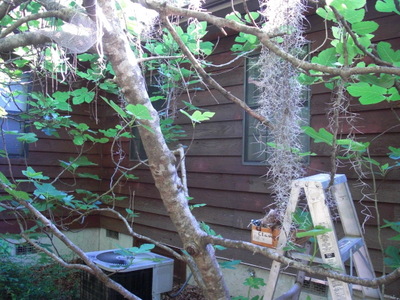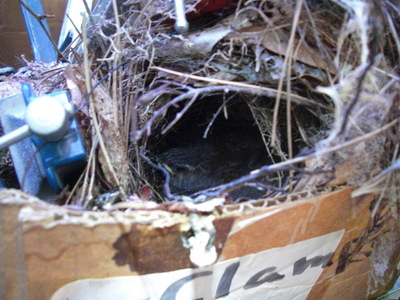Monday, 6 May 2013: Avian Infestation
Written Monday, 6 May 2013
Aargh! The wrens! They've always tried to nest in the garage, but this year they succeeded. In past past, the garage door was open only for a little while in the morning, a little while in the evening, and most of Saturday, so it was mainly a matter of pitching out the nesting materials as they accumulated. Since I retired, though, I'm often home all day, and the garage has stood open for a much higher percentage of the time. By the time we realized a complete nest had been constructed in David's box of assorted wood clamps (on the top level of a bank of metal shelves against the garage's back door), it had four eggs in it. Drat.
I immediately consulted the internet to learn the incubation and nestling times for Carolina wrens, but the ranges were rather large, and we had no way of knowing whether development had yet begun (as in chickens, the eggs are laid over a period of days, but development of chicks begins only when the mother starts incubating them—that way, they all mature and hatch at once). Clearly, it would be touch and go whether the young ones would fledge and leave the nest before we left for Europe and the Garage Door of Doom closed for weeks.
I took to leaving a two-inch gap at the bottom when I closed the garage door, so that the parents could get in and out when we weren't home. The first time we saw a wren bring food to the nest, I used a mirror to peek inside, and sure enough, we had nestlings. Unfortunately, again, we had no way of knowing just when they had hatched—the feeding might have been going on for days before we happened to be watching at the right time to see it. So again, I couldn't be sure whether the little birds would fledge in time.
I consulted an eminent ornithologist (a member of my old department at FSU) about whether, if I moved the nest to a bush outside the garage, the parents would be likely to continue feeding the babies. She suggested I move it gradually, a few feet a day, so on Friday, when it seemed increasingly unlikely that the babies were growing fast enough, I moved it, box of clamps and all, to the little drop-down shelf on our folding stepladder, a couple of feet lower and maybe four feet away from its original shelf. The parents found it okay and kept on feeding, so I breathed a sigh of relief. Saturday, I moved the ladder about halfway to the garage door (moving one of the cars to the driveway for the interim). Again the parents found it, although I watched one parent search around the garage for several minutes, trying to find someone to give its moth to. Sunday, I moved it to a position just inside the garage door, and today, I moved the ladder out of the garage and into the midst of our fig tree, where, yes, the parents are still bringing food to the nest.
Tomorrow morning, before we leave for the airport, comes the trickiest maneuver of all—I will drape a cloth over the nest (because the little guys are now close enough to finished to jump out and scatter in panic if I'm not careful) and move the nest itself out of the box of clamps and into a cradle of wire screening that I have tied into a three-way fork of the fig tree. At that point, the clamps, ladder, and car can be moved back inside. Before we leave, we'll do a sweep to make sure neither of the parents is lurking inside the garage and then close the door definitively. The things I do because I feel sorry for baby birds!

 Here, you can see, in the lefthand photo, the stepladder in the fig tree together with the box of clamps and the nest built into it. At the upper left corner of the photo, you can see the wire-mesh cradle and the dangling ends of the white cotton string I used to fasten it into the tree.
Here, you can see, in the lefthand photo, the stepladder in the fig tree together with the box of clamps and the nest built into it. At the upper left corner of the photo, you can see the wire-mesh cradle and the dangling ends of the white cotton string I used to fasten it into the tree.
In the righthand photo, you can see one of the chicks peering suspiciously at me from the depths of the nest.
The take-home lesson here is that that tale all our parents told us (to get us to leave bird nests alone), to the effect that, if you touched a baby bird, the mother would instantly abandon it and it would die a horrible death, is not true. FSU undergraduates were forever bringing baby birds to us in the biology department, and the eminent ornithologist mentioned above invariably told them to put it back where they found it—no, it wasn't abandoned; they had in fact kidnapped it from its frantic parents, who would welcome it back into the family instantly. I had also edited papers describing experiments in which graduate students had, three or four times in the course of the nesting period, taken the baby birds out of nests, measured them, banded them, and put them back, all without ill effect on fledging success, and I've read an article describing how to protect baby bluebirds from parasites by taking them out of the nest, looking under the nest for the parasites, which lurk there during the day, removing them, then replacing nest and nestlings, again without ill effect on the birds' development. Still, next time and in years to come, we will definitely take pains to discourage garage nesting—we provide trees, bushes, eaves, decks, flower pots, and birdhouses for that kind of thing.
previous entry
List of Entries
next entry

 Here, you can see, in the lefthand photo, the stepladder in the fig tree together with the box of clamps and the nest built into it. At the upper left corner of the photo, you can see the wire-mesh cradle and the dangling ends of the white cotton string I used to fasten it into the tree.
Here, you can see, in the lefthand photo, the stepladder in the fig tree together with the box of clamps and the nest built into it. At the upper left corner of the photo, you can see the wire-mesh cradle and the dangling ends of the white cotton string I used to fasten it into the tree.